|
|
|
Meditation Seeking Understanding ~ Humanity
These pages are meditations on the mysteries of the creation, the incarnation, and the redemption. They explore the Christian understanding that all men and women are consubstantial in one and the same human nature, and are consubstantial with Jesus Christ as to his humanity. The meditations are based on a layman's reading of the Sacred Bible, the Catechism of the Catholic Church, and the Theology of the Body as they pertain to the egalitarian complementarity of man and woman, which transcends the patriarchal binary of mutually exclusive male-female opposites. This understanding of the complementary equality of man and woman applies to all the sacraments, sheds light on the great nuptial mystery of Christ and the Church, and would seem to support the ordination of women to the ministerial priesthood and the episcopate.
|
Natural Unity of Man and Woman
Working Draft - 8 February 2016
PRAELUDIUM
|
In the Catholic Church, the resistance to the ordination of women is rooted in a sacramental theology that conflates the patriarchal gender binary with biblical revelation. This is a meditation on human nature, male and female, as it pertains to the sacramental priesthood of the New Law when unconstrained by the patriarchal priesthood of the Old Law. This is a visceral issue that cannot not be settled by reasoning alone. This page attempts to support prayerful discernment by stepping outside of the patriarchal box and reconsidering the issue in light of the deposit of faith and the signs of the times.
On human nature and personhood:
"The invisible determines man more than the visible."
St. John Paul II, TOB 7:4, 31 October 1979
|
Acronyms and Links:
|
ORIGINAL UNITY OF MAN AND WOMAN
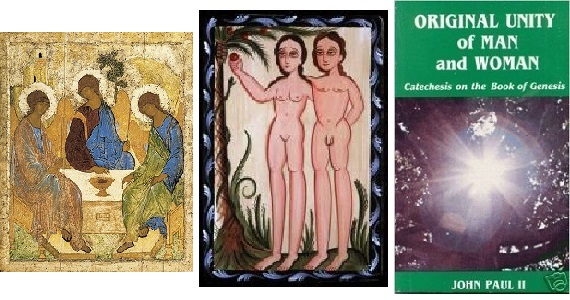
Adam and Eve: Created in the Image of the Triune God, of the Same Flesh and the Same Spirit
Genesis 1:27-28, 31; 2:7, 15, 21-23; 3:6-7, 14-17, 5:1-2; CCC 385, 387, 396, 413-421, 1871; TOB 1:3, 2:4, 3:1-4, 4:2-3, 5:2, 6:1, 7:4, 8:1-4, 9:1-5, 10:1, 70:7, 72:5, 102:4
Images: Rublev's Trinity Icon, Original Unity of Man and Woman
Point: 1 Patriarchy, the culture of male domination and female submission, is ancient and pervasive but is not natural.
Point 2: The sexual differentiation of man and woman is a life giving gift of nuptial love that makes their unity a full image of Trinitarian communion.
Point 3: The TOB deconstructs the patriarchal gender binary. A central point of the TOB is that bodiliness and sexuality are not identical realities. Being a body-person (or body-soul) existentially precedes sexual differentiation. Sex is constitutive but not determinative of the human person.
Point 4: What is determinative? Each human person is created by "an act of enlivening matter by the spirit." This "animation of the body" is what determines that a body made of dust becomes a body-person, a living soul.
|
FROM ORIGINAL SIN TO THE INCARNATION
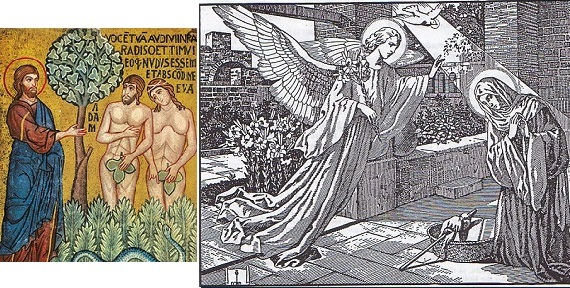
From the Shame of Original Sin to the Incarnation
Genesis 3:16, 2:7, 18-24; 5:1-2, 3-32, 11:10-32, 12:1-3, 21:10; Exodus 3:15, 20:17; Leviticus 12:1-5; Numbers 3:1-15; Deuteronomy 21:10-13; Matthew 1:1-17, 13:3-38, 19:12; Luke 3:23-38; John 1:1-14, 4:23-27, 16:2-13, 17:16, 20:17; CCC 145, 239, 370, 706, 762, 1669, 2676, 2779; TOB 22:5, 27:2, 29, 30, 31, 32, 33
Images: Peccato Originale - Crestin Ortodox and Annunciation/Incarnation - Catholic Books
Point 1: After original sin and the inception of the patriarchal gender binary, the father is the head of the family. The divine feminine is suppressed, and God becomes exclusively male in the image of human patriarchs.
Point 2: Before the incarnation, in this patriarchal culture, wives are the posession of their husbands. Patriarchy is not a intrinsically evil (nothing human is 100% good or 100% bad) but it is an objective cultural disorder derived from original sin.
QUESTIONS: Jesus is the "Son of Man," but was the "Son of God" a male before the incarnation? For the redemption and the sacramental economy, is the human masculinity of Jesus more important than the color of his eyes?
Point 3: God is Love, a pure spirit. Before the incarnation, God did not have a body. At the incarnation, the second Person became flesh in time and space, in a concrete human body, with a concrete patriarchal genealogy, like us in all things but sin. Starting with Mary's free decision at the Annunciation (without asking for Joseph's permission!), the incarnation turned the patriarchal culture upside down and inside out, albeit in a humble way that tolerated resistance to change, not by force.
|
BEFORE AND AFTER THE REDEMPTION
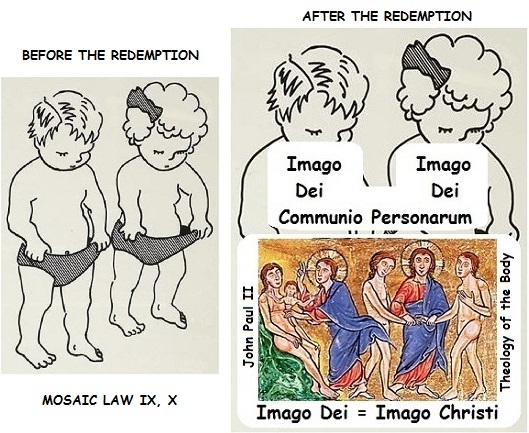
One Flesh, Before and After the Redemption of the Body
Genesis 2:18-24, 12:1-3, 21:10; Exodus 20:17; Leviticus 12:1-5; Numbers 3:15; Deuteronomy 5:21, 21:10-13; Matthew 8:20, 18:11; Mark 10:35-45, 16:1-3; Luke 2:46, 9:58; John 1:1-14; Romans 8:23; Galatians 4:4; Philippians 2:6-8; Hebrews 4:14, 10:5; CCC 145, 706, 762, 1669, 2676; TOB 8:1, 4, 9:1-5, 10:1-4, 19:3-5, 29:1-5, 30:3-5, 31:3-5, 32:3-5, 33:2, 44:6, 55:2-6, 58:3, 59:3, 65:3, 66:1-3, 67:3, 68:1, 69:4-6, 70:5-7, 75:3, 76:6, 78:5, 80:4, 86:1-4, 87:5, 89:1-8, 90:5, 91:6, 92:6, 95:1-7, 95b:1, 96:5, 97:5, 102:4, 116:5, 117b:6, 122:1, 123:7, 129:3-5, 130:5, 133:1
Image: Boy and Girl, Artist Unknown - Union History
Point 1: The original unity of man and woman as created rational animals, and their interpersonal communion, are distorted by the patriarchal gender binary in the culture of ancient Israel. This is a distortion made by human hands, not God's.
Point 2: What really matters for the Christian faith is that God became human, in the flesh, not that he was incarnated as a male. Jesus identified himself as the Son of Man, a human being; he never identified himself as a patriarch. For the redemption, and for the sacramental economy of the New Law, his masculinity is as incidental as the color of his eyes.
Point 3: Jesus Christ is Son of God and Son of Man, one divine Person with two natures, divine and human. The Son of God is "eternally begotten," a divine person that transcends all human limitations of time and space, including sex and gender. Before the incarnation, God is God. After the incarnation, God is God and is, in addition, a human being.
|
MOSAIC LAW, PATRIARCHAL CULTURE
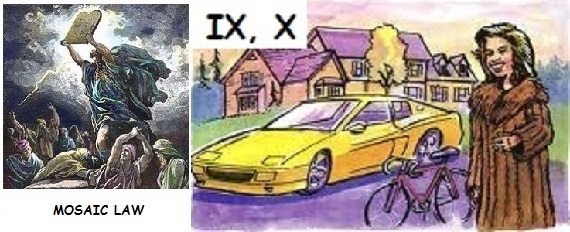
The Mosaic Law and the Patriarchal Culture of the Old Testament
Genesis 3:16, 12:1-3, 21:10; Exodus 20:17; Leviticus 12:1-5; Numbers 3:15; Deuteronomy 5:21; Luke 2:22-40; Galatians 4:4; CCC 145, 706, 762, 1669, 2534, 2676; TOB 2:4, 4:3, 5:5-6, 6:3, 8:1, 10:1, 19:4, 21:3, 45:1, 44:6, 55:2, 60:1-2, 69:2, 72:5, 85:9, 86:4, 93:3, 95:6, 99:4, 102:5, 119:4
Image: God & Moses
N.B. The 9th and 10th commandments tacitly assume that, together with other assets, wives were the property of their husbands. Lamentably, this patriarchal mindset still prevails in some regions of the world, and even in some Christian communities.
Point 1: Time and place: Israel, before the incarnation and the redemption. Jesus of Nazareth was born under the Law. His parents were subject to the Law and he willingly remained subject to the Law. The ten commandments, good as they are, already reflect contamination by the patriarchal culture of male domination and female subordination.
Point 2: The Old Law is understood and articulated as a patriarchal covenant between a God that looks like a divine Patriarch and a people ruled by Moses and other human patriarchs. The father is the head of the family. It is a phallocentric culture of patriarchal domination, of women by men, and of nature by men.
Point 3: It is divine pedagogy that God comes to us where we are. To reveal the divine plan for the New Law in a way that people could understand, the Lamb of God had to be male.
|
CHOSEN PEOPLE, PATRIARCHAL PRIESTHOOD
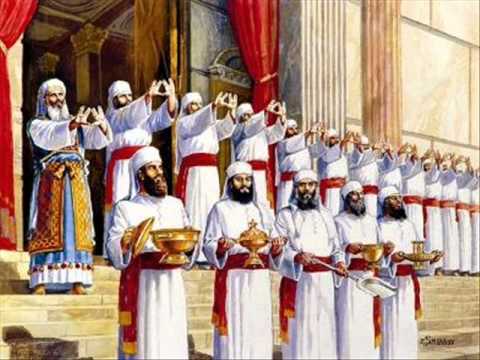
The Chosen People and the Patriarchal Priesthood of the Old Testament
Genesis 3:16, 12:1-3, 21:10 49:28; Exodus 20:17; Leviticus 12:1-5; Numbers 3:15; Deuteronomy 5:21, 21:10-13; Isaiah 42:1-7, 54:7-10; Jeremiah 29:11; Hosea 6:6; Matthew 9:13; Mark 1:29-39; John 4:27; Acts 10:34-38; CCC 145, 706, 762, 1669, 2676; TOB 2:4, 5:5-6, 6:3, 8:1, 10:1, 19:4, 21:3, 45:1, 44:6, 55:2, 60:1-2, 69:2, 72:5, 85:9, 86:4, 95:6, 99:4, 102:5, 119:4
Images: Melchizedek and Levitical Priesthoods
N.B. The Melchizedek priesthood spanned from Adam to Moses (Romans 5:14) until the Gold Calf Covenant Break of Israel (Exodus 32), thrusting the people into a Levitical lriesthood (Hebrews 7:11) until Yahweh re-established the Melchizedek priesthood thru Jesus (Psalm 110:1-4, Hebrews 7:20-24). Both were patriarchal priesthoods, i.e., exclusively male in conformance with Genesis 3:16.
Point 1: Time and place: Israel under the Roman empire, during the public ministry of Jesus. Brute force was normative under the Old Law. Israel conquered or was conquered, depending on the obedience of the people to a warrior God. The prophets (Isaiah, Jeremiah, Hosea, etc.) reminded people of God's mercy, but "an eye for an eye and a tooth for a tooth" remains the basic law of the land under Roman rule.
Point 2: In this culture, the father is the head of the family. Wives are, for all practical purposes, the posession of their husbands. Women are not credible as witnesses. Only male children are counted. The patriarchs of the 12 tribes of Israel are the "fathers" of the chosen people. The patriarchal priesthood is transmitted from fathers to sons. Virility is viewed as the supreme virtue, the summit of humanity.
Point 3: In Jesus of Nazareth, God became a human being, the eternal Word assumed a body of flesh in which he humbly submitted to baptism even though he was sinless, to live and suffer under the Old Law in order to bring about the advent of the New Law and the Good News that God wants mercy, not sacrifice.
|
COLLOQUIUM
This meditation does not attempt to "prove" anything. It is a personal reflection about a visceral issue that cannot be resolved by reasoning alone, and prayerful discernment of Christ's will is required. The truth is timeless, but the Church's understanding of the truth is not timeless; the faith is always the same but the Holy Spirit enables the Church to bring out of the deposit of faith what is new and what is old (cf. Matthew 13:52).
Lord, grant me the serenity to accept what I cannot change,
The courage to change what I should change,
And the wisdom to know the difference.
Mary, Mother of the Church and Untier of Knots, pray for us.
|
|Back to Title|
PelicanWeb Home Page
Index of Meditations
|
|
|
|